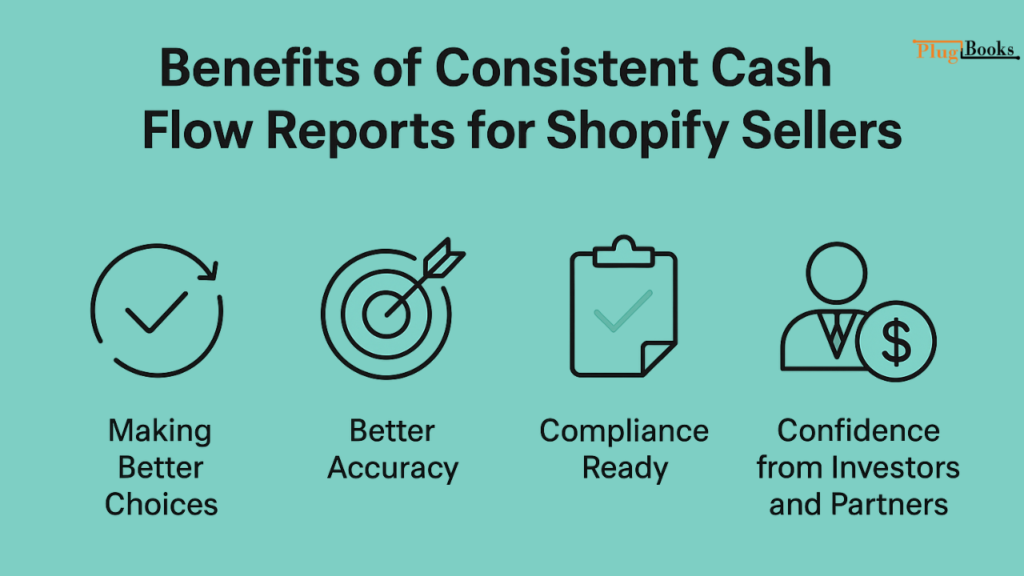Running a Shopify store without consistent financial reporting is like selling blind. You may see orders coming in, but without clear financial insights, it’s hard to know if your business is truly profitable. Reliable financial reporting ensures your Shopify store’s financial data is accurate, up-to-date, and easy to understand, helping you make smarter decisions and grow faster.
Whether you sell a few products or run a large Shopify store, maintaining structured financial reports helps track performance, spot trends, and ensure compliance with accounting standards.
Key Points
- Reliable Insights: Consistent reports provide trustworthy data for decision-making.
- Better Profit Tracking: Know which products or categories are most profitable.
- Error Reduction: Standardized processes minimize mistakes in financial statements.
- Compliance Assurance: Stay ready for taxes and audits.
- Investor & Stakeholder Confidence: Transparent reporting builds trust and credibility.
What Are Consistent Financial Reporting?
It is making financial statements and reports using the same processes, timelines, and forms every time. This implications for Shopify sellers:
- Keeping precise records of all sales, costs, and refunds
- Using the same templates for balance sheets, income statements, and cash flow statements
- Reporting on a regular basis, as once a week, once a month, or once a quarter
- Following accounting rules to make sure that things are accurate and can be compared throughout time
Shopify store owners can easily keep an eye on how their stores are doing, predict how much money they’ll make, and plan how to grow their businesses with regular financial reporting.

Understanding Types of Financial Reports on Shopify
Types of financial reports are quite important for Shopify sellers to be successful. This is what you need to know:
- The income statement shows how much money your Shopify store made, spent, and made in net profit over a certain time period. This lets you figure out how much money your store makes.
- Balance Sheet: Shows you what your assets, debts, and equity are worth at a certain point in time. Good for figuring out how healthy your finances are generally.
- The Cash Flow Statement shows how money comes in and goes out of your Shopify store. It is important to make sure you can pay your bills and put money back into your firm.
- Statement of Shareholder Equity: If your Shopify store has more than one owner, this indicates how ownership equity has changed, including retained earnings.
You can also refer to a financial report sample for Shopify stores to understand how these statements are structured and customized for ecommerce.
For more detailed insights, check out Shopify Reporting with PlugBooks and Report Shopify Store.
Real Shopify Seller Experience
Sarah is a Shopify seller who owns a modest store that sells handmade jewelry. At first, it was hard for her to figure out which products were really making money because her reports weren’t always clear. Sarah was able to do the following after she started doing regular Cash flow report and using PlugBooks Ecommerce Reporting:
- Keep an accurate record of your monthly income and expenses
- Find out what sells well and get rid of stuff that isn’t making money.
- Automate making reports to save hours every week.
Because of this, Sarah not only made more money, but she also felt more sure about her business choices.

Benefits of Consistent Cash flow report for Shopify Sellers
There are many benefits to using consistent Cash flow report in Shopify:
- Making Better Choices: Clear reports make it easy to find your best-selling items, your most profitable categories, and your slow-moving stock.
- Better Accuracy: Standardized reporting makes Shopify’s sales and financial data less likely to be wrong.
- Compliance Ready: Regular reports make sure your Shopify store is ready for taxes and audits.
- Confidence from Investors and Partners: Clear Business report help investors, partners, and lenders trust you.
You can also explore integrations like Amazon and Shopify Integration to consolidate orders and reporting across platforms.

Shopify Accounting report Developments to Watch
Shopify businesses can stay competitive by keeping up with changes in ecommerce accounting reports. Some of the things that are happening right now are:
- Automated Shopify accounting connections, such as QuickBooks or PlugBooks
- Dashboards for sales, inventory, and cash flow on Shopify in real time
- AI-powered information for predicting costs and income
For Shopify sellers using payment solutions like Klarna, Klarna Shopify Integration can help track transactions consistently.
Steps to Achieve Consistent Financial Overview on Shopify
- Use Standardized Templates: Keep all Shopify Financial overview in a consistent format.
- Schedule Regular Reporting: Weekly or monthly reporting ensures you track store performance effectively.
- Automate Where Possible: Connect Shopify with tools like PlugBooks Shopify Bookkeeping to automate income, expense, and cash flow tracking.
- Stay Updated: Follow Financial overview developments to optimize your reporting process for Shopify growth.
You can also calculate profitability with Shopify Calculator for accurate financial insights.

FAQs
Q1: How often should Shopify sellers generate Profit and loss report?
A1: Ideally, Shopify sellers should generate monthly reports, but weekly summaries for sales and cash flow can help make quicker decisions.
Q2: Can I automate consistent Profit and loss report for my Shopify store?
A2: Yes! Tools like PlugBooks can automate reporting, sync sales across platforms, and reduce manual errors.
Q3: What is the most important report for Shopify sellers?
A3: While all reports are important, the income statement and cash flow statement are critical for tracking profitability and liquidity.
Q4: Do consistent company reports help with taxes?
A4: Absolutely. Regular, standardized reports ensure you have accurate records for tax filings and audits.
Q5: How do I start implementing a consistent Company report?
A5: Begin by standardizing templates, scheduling regular reporting, and using automation tools to simplify the process.
Final thoughts
For Shopify sellers, a regular accounting report is very important for long-term success. You can make smart choices, stay in compliance, and grow your Shopify business with confidence by knowing about several sorts of accounting reports, such as the income statement, balance sheet, cash flow statement, and statement of shareholder equity, and using tools like PlugBooks.



